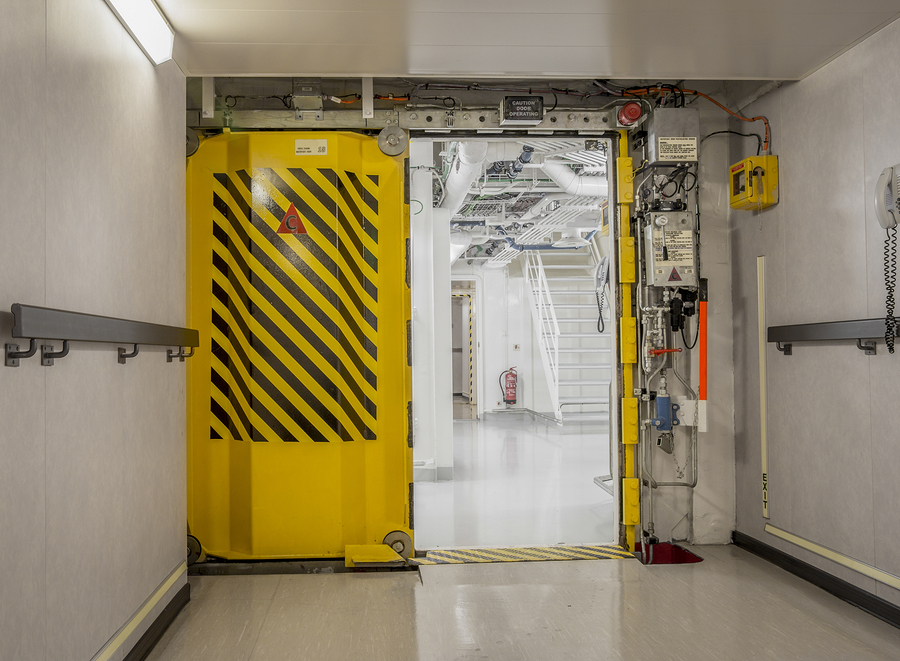At first glance, watertight door safety may not seem like the most riveting topic, but their ability to crush limbs and kill is alarming
Watertight doors are mandatory and the reason is based on the premise that ships need watertight compartments in case of an emergency, but also need access for crew and maybe passengers to freely move around the ship. However, their ability to close quickly, and crush, amputate limbs and even kill unlucky passers-by, would leave even the most committed horror movie goers in shock. But is there a simple solution to solve this fatal problem?

These doors are actually a major safety device that prevent water moving from one compartment to another if there is a breach of the hull for example, thus reducing flooding or delaying it long enough to allow for an evacuation of a stricken vessel.
These doors can be operated from both the bridge control and by a local control. According to the Marine Accident Investigation Branch, most accidents happen when the doors have been closed from the bridge and crew members then have to use local controls to open or close the doors. For this, two hands are required. Often, they do not wait for the doors to be fully opened and become trapped when their clothing snags on something or they have their hands too full to be able to operate the door properly.
The major issue with watertight doors on ships is that they do not have a spring-back approach, so if something gets stuck, it’s going to get seriously stuck. Senior Nautical Secretary at Nautilus International, Allan Graveson explains to fathom-news, that when you step into a lift and you become caught, the door stops, giving you time to free yourself. This mechanism is also applied to watertight doors in the offshore sector, but not to current commercial ships.
Why? Because, according to Graveson, the vessel is seen as more important than the individual and worst of all, a seafarer is seen as a disposable commodity.
What he means is that watertight doors are essential to prevent flooding and save the lives of thousands of passengers, as well as the entire vessel. They have to be used. A loss of a single passenger is around US $430,000, whereas the loss of a seafarer can be as little as US $1,200, Graveson estimates. While the exact cost for retrofitting doors to the spring back mode is unknown, Graveson believes it is miniscule, but it won’t be done because it’s not mandatory. He says the industry finds safety a very difficult concept and regrettably, sees no change in the foreseeable future.
Furthermore, the reluctance from seafarers to voice concerns over safety issues is a big problem says Graveson. For fear of losing one’s job, this is a no-go area.
So, what can realistically be done to make operation of these doors safer? As with most aspects of safety, it lies in training and educating crew. More training is needed but this is a second substitute, and what Graveson really wants to see is the use of virtual reality (VR) and door design. The problem can be designed out by adopting the use of watertight doors from the offshore sector, but as explained before, this is met with industry resistance. However, Graveson emphasises the importance of using VR to replicate practical procedures.
The other option is to do with colour and design. While this may not be an immediate thought, as Graveson explains it makes complete sense. The way something is perceived will vary from seafarer to seafarer, but positioning the doors in relation to adjacent machinery and bulkheads and even the colour of the doors will alter the perceived depth and distance and the overall physical presentation. This is something which could really change the way crew handle the doors.
There is one thought that came following the Titanic’s sinking, and that was that the watertight doors actually led to flood water being collected at the bow, causing the vessel to essentially pull herself under. This is a possibility says Graveson and there are some thoughts that by letting the water spread more evenly along all compartments, the speed at which a ship would flood would allow time for evacuation. This could reduce the need for as many watertight doors. Though this may depend on the nature of the flooding.
Graveson believes the best option is to subdivide the vessel to a greater degree, allowing water to evenly spread itself but keeping hold of some watertight doors to prevent total flooding.
But what is really needed is regulatory change to allow for watertight doors to be made with a safety provision built in, and for the industry to recognise the value of a seafarer’s life.
Fathom-News
editor@fathom-mi.com
































